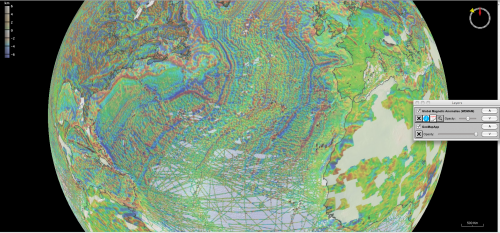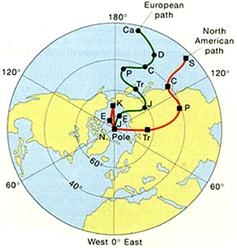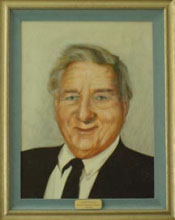Biographical Information
Stanley Keith Runcorn was born in South Port, England 19 November, 1922. He attended Cambridge University and received an engineering degree in 1942. He earned his doctorate at Manchester University focusing his research on the Earth's magnetic field. During World War II Runcorn used his talents to research radar. Runcorn's work on paleomagnetism throughout the 1950's while serving as chair for the Geophysics Department at Cambridge and later at the University of Newcastle on Tyne, led to his publishing of Continental Drift in 1962.
In 1956 Runcorn was appointed chair of the Physics Department at Newcastle. Newcastle became an important, internationally known center of geophysics during his tenure. After retiring from Newcastle in 1988, Runcorn accepted the position of Sydney Chapman Professor in Physical Science at the University of Alaska in Fairbanks. Stanley Keith Runcorn was murdered during a robbery in San Diego, California on December 5, 1995.
Specific contributions to the theory of plate tectonics and/or our modern view of the solid Earth
Keith Runcorn used his research in geomagnetism and paleomagnetism to help usher in the concept of a dynamic and elastic Earth rather than a static Earth. Runcorn applied intensive statistical analysis of the ancient record of Earth magnetic poles trapped in sedimentary and igneous rock. He studied rocks from the United States and Europe and found that the magnetic orientation contained in the rocks pointed to a large-scale movement of Earth's magnetic poles. He mapped the polar migration of rocks from different geologic periods and found that the migration routes were different for the rocks of North America and Europe. This suggested to him that over time Earth's poles have undergone great movement. The movement was termed polar wandering. He further found that the only way the migration paths made sense was if the land masses themselves had moved. His research supported the theory of continental drift proposed by Alfred Wegener in 1912.

Image Source: Produce from Virtual Ocean Global Magnetic Anomalies (WDMAM Basemap)
While not actually giving supporting evidence, Runcorn proposed that the rocks of the lithosphere might creep or flow under high pressure and temperature. He suspected that convection currents within the Earth generated by the great heat and pressure could be the force that moved the continents. His findings on polar wandering, and polar reversals, contributed to our current modern theory of plate tectonics.

Image Source: From H. Levin, The Earth Through Time, 4th Ed., Saunders
Other important scientific contributions
Runcorn went on to research related fields of science, particularly the magnetic fields of the Moon and planets, convection currents within Earth and the Moon, changes in the length of an Earth day, and ocean currents.
Other cool stuff you should know
Keith Runcorn received numerous awards including the Gold Medal of the Royal Astronomical Society, the Wegener Medal of the European Geophysical Society and the John Adam Fleming Award of the American Geophysical Union. Runcorn served in committee overseeing Biosphere II Space Habitat in Arizona from 1991 - 1993. He also served in Pope John Paul II's science advisory panel.
Bibliography
Runcorn, S.K. (1922-1995)." World of Earth Science. 2003. Retrieved January 31, 2011 from Encyclopedia.com: http://www.encyclopedia.com/doc/1G2-3437800522.html
Retrieved from:
http://bowfell.geol.ucl.ac.us/~lidunka/GlobalGeophysics/Geophysics-1
Retrieved from:
http://www.ldeo.columbia.edu/vetlesen/recipients/1970/runcorn_bio.html
Retrieved from:
http://science.jrank.org/pages/47959/paleomagnetism-continental-drift.html
